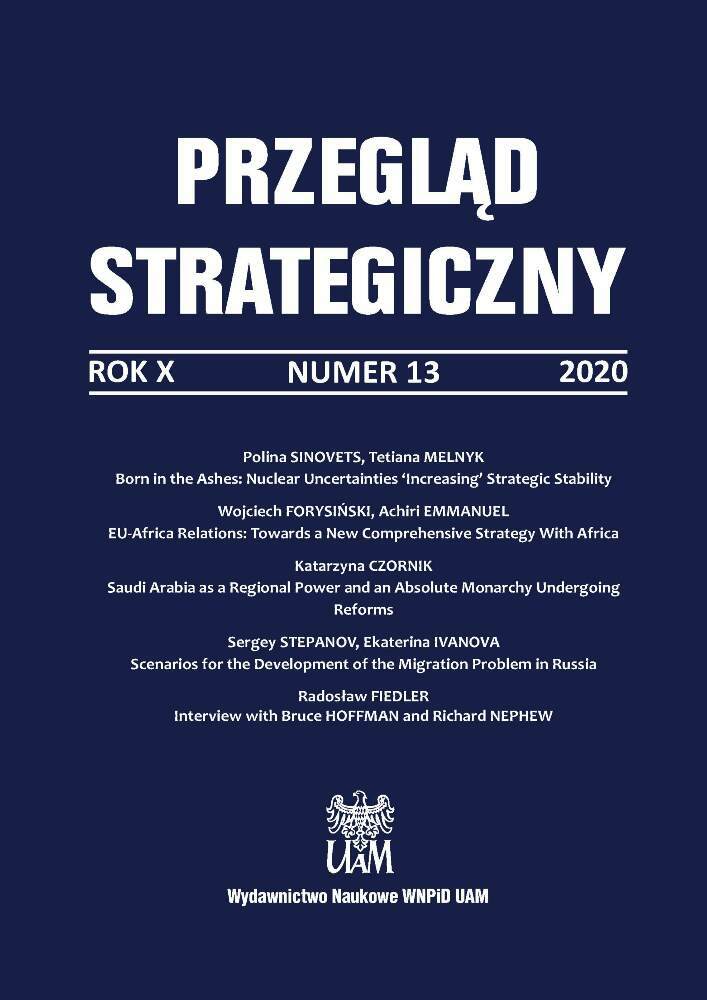Abstract
The South China Sea is the most inflammable area in the region of Southeast Asia due to its natural resources, commercial and political importance. The ASEAN countries directly involved in the dispute have conflicting interests, mainly related to their relationship with China, a pretender for the whole area. Therefore, attemps to settle the dispute are not successful. On July 12, 2016, the Permanent Court of Arbitration in The Hague issued a verdict taking into account the Law of the Sea, in which it accepted the Philippines’s arguments and rejected China’s claims based on historical arguments against the islands in the South China Sea. China did not take part in the trial and found its sentences non-binding but at the same time it has entered into a dialogue with ASEAN on the code of conduct (COC) in the South China Sea. The purpose of the article is to discuss how the parties are involved in the conflict, progress towards signing the Code of Conduct for the Parties in the South China Sea and the attitude of ASEAN countries to this conflict. Due to the degree of dependence of economies on Chinese influence, and relations with other powers, mainly the US, the behavior of individual countries is different. Hence the problem with the organization’s cohesion and attempts to break the deadlock, which have been unsuccessful so far. The basic research hypothesis that will be verified is to maintain the status quo in the South China Sea in the long run. At the same time, it was noted that Vietnam is prepared for long-term actions, based on diplomatic tools combined with a tough attitude, to solve problems related to the sovereignty of disputed areas. ASEAN will have to face up with the issues more consistently, by making greater use of quiet diplomacy. The theoretical basis of the article is Hurrell’s theory of neorealism, which analyzes, among other things, the principles and objectives of regional organizations in the international environment. Hurrell assumes that all regional organizations cannot be understood differently from their regional balance of power and regional dominant forces policy and ASEAN’s attitude proves this point of view.
References
Ang Cheng Guan (2019), Southeast Asia after the Cold War. A Contemorary History, Nus Press Singapore.
Chairman’s Statement, http://asean.org/storage/2017/04/Chairs-Statement-of-30th-ASEAN-Summit_FINAL.pdf (05.06.2017).
China Power, https://chinapower.csis.org/much-trade-transits-south-china-sea/ (15.11.2019).
China Says Ready to Work With ASEAN for South China Sea Peace, https://www.usnews.com/news/world/articles/2019-11-03/china-says-ready-to-work-with-asean-for-south-china-sea-peace (20.02.2020).
CIA, The World Factbook, https://www.cia.gov/library/publications/the-world-factbook/rankorder/2241rank.html (15.11.2019).
Commission on the Limits of the Continental Shelf (CLCS) Outer limits of the continental shelf beyond 200 nautical miles from the baselines: Submissions to the Commission: Joint submission by Malaysia and the Socialist Republic of Viet Nam, http://www.un.org/Depts/los/clcs_new/submissions_files/submission_mysvnm_33_2009.htm (29.06.2017).
Fravel T. M., The United States in the South China Sea Disputes https://www.swpberlin.org/fileadmin/contents/products/projekt_papiere/BCAS2012_Taylor_Fravel_web_final_ks.pdf (12.02.2016).
Glosy M. A. (2007), Stabilizing the back yard: Recent development In China’s Policy Toward Southeast Asia, in: (eds.) J. Eisenman, E. Hegingotham, D. Mitchell, China and the Developing World: Beijing’s Strategy for the 21st Century, M.E. Sharpe, Armonk, N.Y., pp. 150–188.
Hoang Viet (2009), ASEAN and the Prospect for Solution to Disputes In the South China Sea, in: The South China Sea: Cooperation for Regional Security and development, Hanoi.
Hurrell A. (1995), Regionalism In Theoretical Perspective, in: Regionalism In World Politics. Regional Organisation and International Order, (eds:) L. Fawcett, S. Hurrell, Oxford University Press, Oxford–New York.
International Policy Digest, http://www.internationalpolicydigest.org/2014/06/17/exposing-chinas-artificial-islands-plan-spratlys/ (20.06.2014).
Join Statement On the Application Of the Code for Unplaned Encounters At Sea In the South China Sea, http://asean.org/storage/2016/09/Joint-Statement-on-the-Application-of-CUES-in-the-SCS-Final.pdf (05.06.2017).
Joint Statement after the meeting Between Raksha Mantri and Japanese Defence Minister in New Delhi, http://pib.nic.in/newsite/PrintRelease.aspx?relid=147097 (13.11.2016).
Joint Press Briefing, http://asean.org/storage/2017/05/14th-SOM-DOC-Co-Chairs-Joint-Press-Briefing-Remarks-As-delivered-18-May-amen.pdf (05.06.2017).
Laksama E. A., The Domestic Politics of Indonesia’s Approach to the Tribunal Ruling and the South China Sea, “Contemporary Southeast Asia” 38 (3), p. 382–388, https://static1.squarespace.com/static/57e3c9e1d1758e2877e03ba5/t/5b3868130e2e72597373ffb7/1530423316116/CSEA_The_Domestic_Politics_of_Indonesias_Appr.pdf (12.06.2017).
Lee Seok Hwai, Malaysia calls for South China Sea dispute to be resolved by diplomatic and legal processes after Hague ruling, http://www.straitstimes.com/asia/se-asia/malaysia-calls-for-south-china-sea-dispute-to-be-resolved-by-diplomatic-and-legal (05.07.2017).
Linh Tong, The ASEAN Crisis, Part 1: Why the South China Sea Is a Critical Test, “The Diplomat”, 21 December 2016, http://thediplomat.com/2016/12/the-asean-crisis-part-1-why-the-south-china-sea-is-a-critical-test/ (09.07.2017).
Lokshyn G. M. (2014), Juzhno-kitajskije Morie: Do Mira i Spokojstwija jeshcho dalieko, (South China Sea: A Long Way to Peace and Agreement), Tichookieanskoje Obrazowanije 2012–2013, Moscow.
Metelitsa A., Kupfer J., Oil and Gas Resources and Transit Issues in South China Sea, http://asiasociety.org/files/SouthChinaSea_OilGas_brief.pdf (27.06.2017).
Mogato M., ASEAN gives Beijing a pass on South China Sea dispute, cites ‘improving cooperation’, http://www.reuters.com/article/us-asean-summit-idUSKBN17W02E (05.07.2017).
Nguyen Ha, Vietnam Gets a US Confidence Boost in China Sea Dispute, https://www.voanews.com/east-asia-pacific/vietnam-gets-us-confidence-boost-china-sea-dispute (05.11.2019).
Nguyen Minh Quang, Saving the China-ASEAN South China Sea Code of Conduct, https://thediplomat.com/2019/06/saving-the-china-asean-south-china-sea-code-of-conduct/ (29.10.2019).
PCA Case Nº 2013-19 In the matter of the South China Sea Arbitration, https://pca-cpa.org/wp-content/uploads/sites/175/2016/07/PH-CN-20160712-Award.pdf (05.01.2016).
Portiakov V. (2012), O niekatorych osobiennostiach wnieshniej polityki Kitaja w 2009–2011 [On Selected Characteristic Features of China’s Policy in the Years 2009–2011], “Probliemy Dalniego Vostoka”, No. 2.
Sobczyński M. (2008), Uwarunkowania geopolityczne międzynarodowego sporu o Wyspy Spratly (Geopolitical Conditions of the International Conflict about Spratly Islands), in: Problemy rozwoju państw azjatyckich (Development Problems of Asian States), ed. J. Marszałek-Kawa, Wyd. Adam Marszałek, Toruń.
Statement on Award of Arbitral Tribunal on South China Sea Under Annexure VII of UNCLOS, http://www.mea.gov.in/pressreleases.htm?dtl/2701/Statement+on+Award+of+Arbitral+Tribunal+on+South+China+Sea+Under+Annexure+VII+of+UNCLOS (13.11.2016).
Statement by Malaysia, Ministry of Foreign Affairs of Malaysia Putrajaya 12.07.2016, https://www.kln.gov.my/web/guest/home?p_p_id=101&p_p_lifecycle=0&p_p_state=maximized&p_p_mode=view&_101_struts_action=%2Fasset_publisher%2Fview_content&_101_returnToFullPageURL=http%3A%2F%2Fwww.kln.gov.my%2Fweb%2Fguest%2Fhome%3Fp_p_id%3D3%26p_p_lifecycle%3D1%26p_p_state%3Dnormal%26p_p_state_rcv%3D1&_101_assetEntryId=8393068&_101_type=content&_101_urlTitle=press-release-following-the-decision-of-the-arbitral-tribunal-on-the-south-china-seaissue&redirect=http%3A%2%2Fwww.kln.gov.my%2Fweb%2Fguest%2Fhome%3Fp_p_id%3D3%26p_p_lifecycle%3D0%26p_p_state%3Dmaximized%26p_p_mode%3Dview%26_3_keywords%3Dsouth%2Bchina%2Bsea%26_3_struts_action%3D%252Fsearch%252Fsearch&inheritRedirect=true (31.10.2020).
Termsak Chalermpalanupap (2016), No ASEAN Consensus on the South China Sea, “The Diplomat”, 21 July, http://thediplomat.com/2016/07/no-asean-consensus-on-the-south-china-sea/ (05.07.2017).
“The Economist”, 27 May 2017.
The Jakarta Post 07, 2016, https://www.thejakartapost.com/seasia/2016/07/12/indonesia-urges-parties-to-respect-laws-following-south-china-sea-ruling.html (29.10.2019).
“The New York Times” 14.07.2016, https://www.nytimes.com/2016/07/15/world/asia/south-china-sea-dispute-arbitration-explained.html (17.06.2017).
US Energy Information Administration, https://www.eia.gov/beta/international/analysis_includes/regions_of_interest/South_China_Sea/south_china_sea.pdf (17.06.2017).

